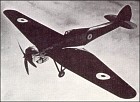
|
Bristol Boxkite 1910 |
First product of the Bristol and Colonial Aeroplane Company and one of the most famous British pioneering aircraft. The first ... read more ... |

|
Bristol Scout D 1915 |
Derived from a single-seat sports biplane designed by Frank Barnwell, first flown in February 1914 and retrospectively known as the ... read more ... |
Designed by Frank Barnwell assisted by Leslie G Frise,
the T.T.A. (Twin Tractor Model A) was intended to
meet a requirement for ... read more ... |
Bristol T.T.A 1916 |
 |

|
Bristol M.1C 1916 |
The M.1C was the production derivative of the private-venture
M.1A which, designed by Frank Barnwell, had
flown for the first time on ... read more ... |
Known by the appellation of "Fighter" almost from its
birth, the F.2 series of two-seat fighter-reconnaissance
aircraft designed by Frank Barnwell was ... read more ... |
Bristol F.2A Fighter 1916 |
 |

|
Bristol S.2A 1916 |
A derivative of the Scout D intended to meet an
Admiralty specification for a two-seat fighter, the S.2A
had side-by-side seating and ... read more ... |
The F.2B two-seat fighter-reconnaissance aircraft differed
from the F.2A in having a revised centre fuselage
to provide improved pilot view, an enlarged ... read more ... |
Bristol F.2B Fighter 1917 |
 |

|
Bristol Scout F 1917 |
Originally intended for a 200hp Hispano-Suiza engine,
the Scout F was initiated by Frank Barnwell in June
1917, subsequently being redesigned to ... read more ... |

|
Bristol Scout F.1 1918 |
The shortcomings of the Arab engine led, at an early
stage in the development of the Scout F, to an investigation
of ... read more ... |
Intended as a successor to the F.2B two-seat fighterreconnaissance
aircraft, the F.2C Badger was designed for the 320hp ABC Dragonfly I ... read more ... |
Bristol F.2C Badger 1919 |
 |

|
Bristol Bullfinch I 1923 |
In July 1920, Capt Frank Barnwell and his team began
design work on an all-metal parasol fighter monoplane
intended to be built ... read more ... |
Designed by Wilfrid T Reid to meet Air Ministry Specification
3/22 issued in June 1922 for a two-seat fighter,
the Bloodhound was ... read more ... |
Bristol 93 Bloodhound 1923 |
 |

|
Bristol 105 Bulldog 1927 |
Between the World Wars the Bristol Aeroplane Company had very few successful designs. The outstanding one that kept the big ... read more ... |
Specification 4/24 issued in 1924 called for a multi-seat
twin-engined fighter capable of carrying two of the
37mm Coventry Ordnance Works (COW) ... read more ... |
Bristol Bagshot 1927 |
 |

|
Bristol 101 1927 |
Designed as a private venture, the Type 101 two-seat
fighter powered by a 450hp Bristol Jupiter VI ninecylinder
radial was of mixed ... read more ... |

|
Bristol 133 1934 |
A further private venture design for the F.7/30 competition,
the Type 133 single-seat fighter featured a forward
fuselage of girder-type construction, a ... read more ... |
The Type 123 was built as a private venture to meet the
requirements of Specification F.7/30, a 695hp Rolls-
Royce Goshawk III ... read more ... |
Bristol 123 1934 |
 |
Single-seat high-altitude research monoplane powered by a
372.6kW Bristol Pegasus P.E.6S radial
engine. Flown by Sqn Ldr F. R. D. Swain, it
achieved ... read more ... |
Bristol 138A 1936 |
 |

|
Bristol 146 1938 |
Embodying the lessons learned from the Type 133, the
Type 146 was a single-seat eight-gun all-metal fighter
of monocoque construction with stressed ... read more ... |

|
Bristol 164 Brigand 1944 |
The Brigand was designed as a twin-engined three-seat long-range attack aircraft capable of fulfilling the duties of a torpedo-bomber, dive-bomber ... read more ... |
The Type 167 Brabazon was designed as a fully pressurised passenger airliner specifically for operating the direct London to New ... read more ... |
Bristol 167 Brabazon 1949 |
 |

|
Bristol 175 Britannia 1952 |
The Type 175 Britannia, the world's first large turboprop transport aircraft, began as a piston-engined design to meet BOAC's 1947 ... read more ... |
The Bristol 188, sometimes called the 'flaming pencil', was designed to
research structures for sustained supersonic flight, particularly in
support of the ... read more ... |
Bristol 188 1962 |
 |
| 
